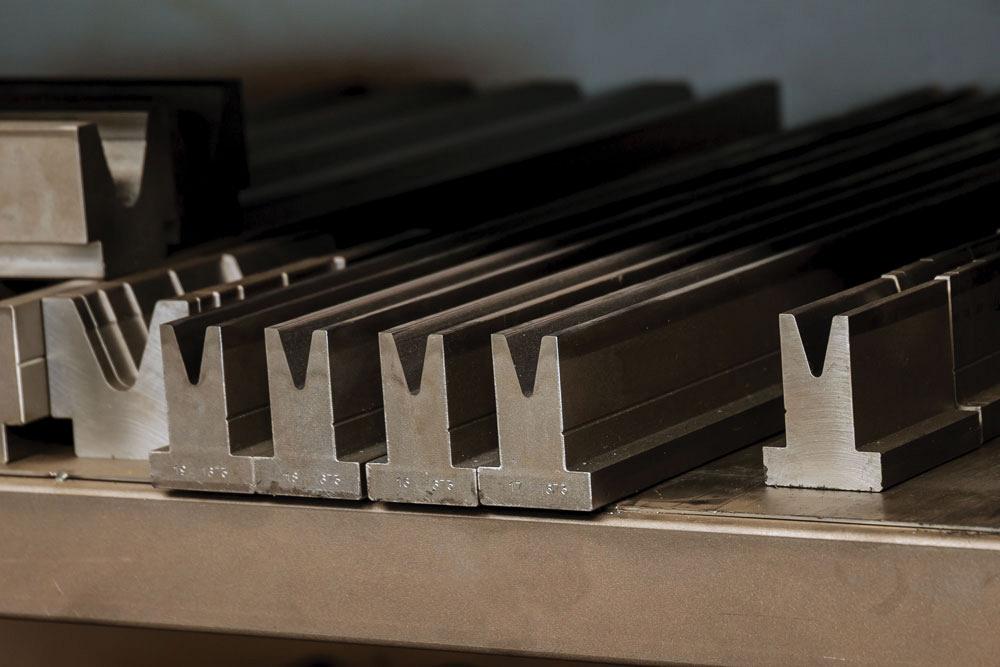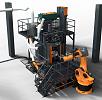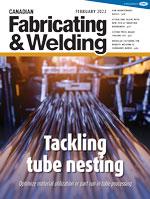Business Development Manager
- FMA
- The Fabricator
- FABTECH
- Canadian Metalworking
Extend press brake tooling life
Proper storage and maintenance techniques
- By David Bishop
- March 4, 2022
- Article
- Fabricating

The old traditional method of storing tooling on a long open rack at the back of the shop is no longer acceptable and exposes the tooling to potential damage from a range of sources. ZhakYaroslavPhoto/iStock/Getty Images Plus
Today’s press brakes have multiaxis controls with up to eight axes. Many are programmed with highly advanced offline programming systems. Some now come with open height dimensions of up to 30 in. or more, with stroke lengths close to half that amount. Hydraulic clamping and CNC crowning systems have become commonplace. And one of them often can replace as many as three older machines.
To maximize the capabilities of these highly productive marvels of technology, the tooling itself had to become taller, far more versatile, ultra-fast to load and unload, provide like-new accuracy for 10 years or more when used properly, provide unparalleled operator safety, not to mention finished parts of the highest quality.
While all of this technology has resulted in a huge increase in productivity, it has come at a cost. Press brakes that cost $250,000 when combined with some of the features mentioned above and tooling packages for these machines costing $25,000 to $40,000 and even higher are no longer uncommon. They have become high-value assets and need to be treated as such.
Looking at the matter from a tooling perspective, it is easy to see that the old traditional method of storing tooling on a long open rack at the back of the shop is no longer acceptable. This method exposes the tooling to potential damage from moisture and airborne contaminants, a lack of protection in the event that the storage rack is struck by a forklift, tools striking other tools during loading and unloading, and tools being stored with the pH balance (acidity and alkalinity) from the hands of the press brake operators being left behind.
Counting the Costs
One of the first things fabricators often say when purchasing tooling for a new press brake is that they don’t need a storage cabinet. Understandably, this is often the result of their desire to save money after having committed a lot of it to a new press brake and tooling. Many say that they already have somewhere to store their tooling, or that they are going to make their own tooling storage rack.
In a high percentage of these cases, notice that in a few months or even a few weeks after they have put their new press brake and tooling into service that they have already damaged a few of their tools. Unfortunately, by that time they frequently will have damaged tooling worth as much as 25 to 30 per cent of the cost of a new tool cabinet. Despairing, they might decide then that they need to replace tools and purchase a tool cabinet.
There is no denying that high-quality, precision-ground, and hardened press brake tooling represents a large investment for the first-time buyer. After all, to achieve the extreme accuracy that they need to provide, some press brake tooling manufacturers are using the same CNC grinding machines that aircraft engine manufacturers use to grind their turbine vanes. And needless to say, they are extremely expensive.
The Dos and Don’ts of Press Brake Tooling Storage
So, what are the proper methods of storing and maintaining your press brake tooling? Press brake tooling cabinets provide far better protection than open storage racks by sealing the tooling off from many outside elements. Most also have door locks that work very well at limiting tooling access only to specific personnel. This can help to minimize the problem of tooling not getting returned to where it belongs when not in use.
Like anything, there are good press brake tooling storage cabinets and not so good press brake tooling storage cabinets, and some designs should be avoided.
General-use storage cabinets that are not specifically designed for press brake tooling, which includes tool cabinets that have small dividers that sit in slots in the drawers, are not recommended. These dividers can be arranged to accommodate specific tools, but press brake operators get in a hurry and frequently place tools in the first storage slot that is available.

Press brake tooling cabinets provide far better protection than open storage racks by sealing the tooling off from many outside elements.
The problem with that is when a smaller tool or pieces from two or more sectionalized tools end up in a storage slot that was created to accommodate a larger punch or die, a second, larger storage slot has to be used to store the large tool that was taken from the first large storage slot. As this continues to happen, you frequently end up with tools of the same part number and pieces of sectionalized tools spread out all over multiple drawers within the cabinet. Press brake operators end up wasting time searching for individual pieces of tooling, and especially pieces of sectionalized tooling that they need for the next job.
Generally speaking, avoid storing tools in cabinets with trays and dividers that are made of unpainted steel. Steel ultimately rusts and corrodes, especially in climates with a lot of rain and humidity. That rust and corrosion will eventually be transferred to your tooling.
Of course, it is always easy to build your own tool cabinet out of wood. While they are fairly easy to produce and easy to size as required, wood holds moisture and chemicals. They will both work quickly to cause rust and corrosion to form on your tooling. For example, some people place brand-new tooling in a wooden tool cabinet at the end of the week only to return on Monday morning to find those tools covered in rust.
The tool cabinet design that works best is one that has nylon or polyurethane inserts that all run parallel in the same direction and are sized to fit the dimensions of the tangs on your punches and dies. This eliminates all metal-to-metal contact and the problems mentioned above, as well as the possibility of the sharp corners on punches and dies coming into contact with punch tips and die shoulder radii. Of course, when this happens, the damaged areas of the punch tips and, more likely, the damaged areas along the shoulder radii on the dies can cause marks on the material that you are forming. Unless that damage is carefully removed via an oil stone, those marks can be very problematic when bending unpainted materials such as aluminum, brass, copper, and stainless steel.
Proper Tool Handling
Most press brake operators don’t like to hear this, but it is recommended they wear gloves when handling press brake tooling and the materials that they are forming. Of course, gloves can help to protect their hands from sharp edges, slivers, and burrs on the sheets. They also prevent them from depositing the acidity and alkaline that is present on their hands onto the tooling. Different people have different pH balances; some have very little effect on the surfaces that they touch, while others can corrode even protected metals such as the arms on a pair of glasses within a year. When left on the surface of press brake tooling, it can cause considerable surface corrosion and even destroy the marking on your tooling.
When this happens, press brake operators often struggle to identify the part numbers and some or all of the critical information on your press brake tooling. This can result in delays in getting your press brake back into production when making tool changes.
The Importance of Proper Cleaning and Preservation
Fabricators frequently complain that even though their press brake operators placed a light coat of lubricant on the press brake tooling before placing it back into storage, they found that their tools still suffered a light coat of rust and corrosion when they retrieved them from storage. They wonder how that could have happened. Actually, it is pretty simple.
As covered previously, when the acidity and alkalinity from a press brake operator’s hands are left on the surface of press brake tooling, it can cause considerable surface corrosion. Unless they take time to clean the tooling and remove this material, the only thing that is accomplished when spraying oil or some form of protectant on the tooling before placing it in storage is simply to cover it in oil. The acidity and alkalinity will still remain on the tooling and, consequently, will still work to corrode its surface.
This is why it is critical that your press brake tooling be thoroughly cleaned first and then lightly coated with a lubricant or protectant before placing it into storage. There are a number of methods and products that work very well for this task. Many highly skilled machinists and toolmakers are known to keep a large bottle of rubbing alcohol on their bench along with clean, lint-proof towels to wipe it onto their fixtures to thoroughly clean them. They normally place a light coat of oil on them before returning them to storage.
Alcohol works exceedingly well for the cleaning process, but this process still requires two steps and, of course, more time. Recently a new generation of products have emerged that are designed specifically to clean and protect press brake tooling in a single application. These products work very well and save time.

A concentrated, liquid spray wax, like this one by WILA, can be applied to tools after use to help clean, maintain, protect, and keep the surface of press brake tooling in top condition.
Protect Your Investment
Purchasing high-quality, precision-ground, and hardened press brake tooling can be compared to purchasing a high-performance sports car. Both represent significant investments of your hard-earned cash. Unless you had no other choice, you certainly wouldn’t leave an expensive sports car parked on the street in front of your house. Given the choice, you would park it in a lockable garage when it is not in use. And you would probably expend a lot of effort to keep the paint and other finishes clean and protected to maintain their appearance.
The same is true with press brake tooling. To maintain its performance and surface condition so that your press brake operators can clearly see the markings on it, you need to store it in a lockable cabinet and keep it properly cleaned and protected from rust and corrosion with a quality lubricant. Doing so will help to keep your tooling and, more important, your investment in like-new condition for many years to come.
David Bishop is business development manager, west, for Wila USA, 7380 Coca Cola Dr., Hanover, Md. 21076, 443-459-5496, www.wilausa.com.
About the Author
Related Companies
subscribe now


Keep up to date with the latest news, events, and technology for all things metal from our pair of monthly magazines written specifically for Canadian manufacturers!
Start Your Free Subscription- Trending Articles
FMA Annual Meeting: Ingenuity still key with tech innovations

Messer Canada hosts anniversary event

Welding jacket designed for protection, comfort

Gang punching press system accommodates different parts quickly

Compact swing chamber shot blast machine features robotic workpiece handling

- Industry Events
MME Saskatoon
- May 28, 2024
- Saskatoon, SK Canada
CME's Health & Safety Symposium for Manufacturers
- May 29, 2024
- Mississauga, ON Canada
DiPaolo Machine Tools Open House 2024
- June 4 - 5, 2024
- Mississauga, ON Canada
FABTECH Canada
- June 11 - 13, 2024
- Toronto, ON Canada
Zoller Open House & Technology Days 2024
- June 12 - 13, 2024
- Ann Arbor, MI















